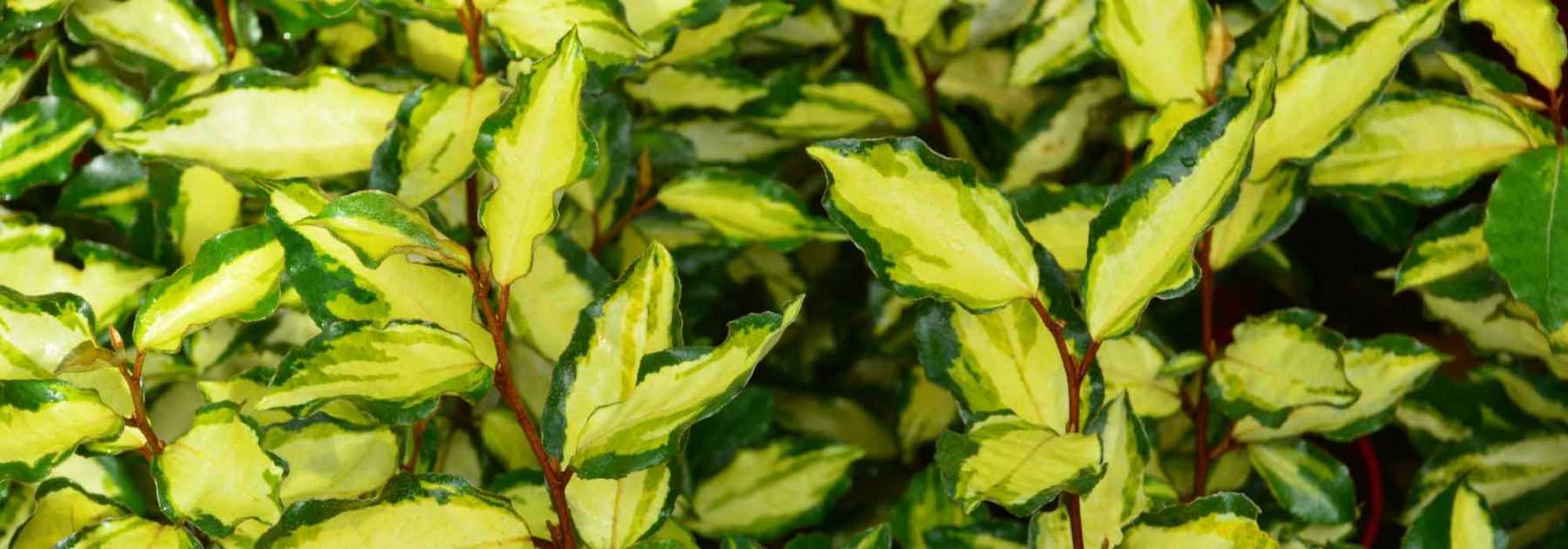
Elaeagnus or Oleaster: Planting, Pruning, Care Tips
Contents
The Eleagnus in a few words
- Elaeagnus is a valuable shrub for its beautiful evergreen foliage
- It’s the shrub of choice for creating hedges
- Its discreet but highly fragrant flowering is followed by edible fruits
- It withstands everything: drought, wind, cold
- Heavy, light, rich or poor – Elaeagnus adapts to all soil types
Our expert's word
Elaeagnus, also known as oleaster, is an all-terrain shrub, highly valued for creating trimmed hedges or windbreaks. It is prized for its luminous green, silver or variegated foliage, deciduous or evergreen depending on the species, and its discreet yet delightfully fragrant flowering followed by edible berries.
The most well-known is the Elaeagnus ebbingei or Ebbing’s Silverberry, from which many yellow-variegated green cultivars originate (Elaeagnus ‘Limelight’, ‘Gilt Edge’ ‘elaeagnus x ebbingei ‘viveleg’) that retain their foliage in winter. There are also other varieties, particularly those with silvery foliage, all equally interesting, such as Elaeagnus angustifolia or “Russian olive” and Elaeagnus pungens Maculata.
Its versatile nature and resistance to pollution make it indispensable in all gardens, whether coastal or urban. Its exceptional adaptability, rapid growth, and dense silhouette allow for numerous uses, from the most classic hedge to the most surprising topiary. Easy to grow and accommodating, Elaeagnus thrives in any well-drained soil, sandy, even dry and poor, without lime, in full sun or partial shade. It is among the shrubs most resistant to drought and strong winds, as well as sea spray.
Discover our Elaeagnus or oleaster, hardy and resilient, they will bring a true source of light to your garden.
Description and botany
Botanical data
- Latin name Elaeagnus
- Family Elaeagnaceae
- Common name Eleagnus, Chalef, Oliver de Bohème
- Flowering mai à novembre
- Height 2 à 10 m
- Exposure Soleil, mi-ombre
- Soil type Tous, bien drainés
- Hardiness -15°C-20°C selon les variétés
Elaeagnus or oleaster is a small deciduous or evergreen tree or shrub, sometimes thorny, belonging to the Elaeagnaceae family. The genus comprises 45 species growing naturally along waterways but also on grassy hillsides and in dry meadows of Asia, southern Europe and North America.
Among the most commonly cultivated are: Elaeagnus angustifolia, also called “Russian olive” with foliage resembling that of an olive tree; Elaeagnus commutata, a large and rare beautiful shrub with deciduous silvery-grey foliage; Elaeagnus umbellata and multiflora (goumi); Elaeagnus pungens; and the very widespread Elaeagnus ebbingei, a persistent hybrid between Elaeagnus macrophylla and pungens, and its numerous cultivars.
 The shrub takes about a year to establish itself, then shows moderate to very rapid growth. The rootstock of some species spreads through suckering, allowing it to fill out in just a few years. It forms a dense, well-branched clump with a small trunk, reaching 1 to 10 m in height at most, with nearly equal spread.
The shrub takes about a year to establish itself, then shows moderate to very rapid growth. The rootstock of some species spreads through suckering, allowing it to fill out in just a few years. It forms a dense, well-branched clump with a small trunk, reaching 1 to 10 m in height at most, with nearly equal spread.
Elaeagnus has a variable, broad habit – upright, rounded or slightly weeping. Some, like Elaeagnus angustifolia, develop a weeping form with branches that arch slightly over time. Elaeagnus x reflexa, rarely cultivated, is unique as a semi-climbing evergreen vine equipped with spurs that allow it to cling to trees and create impenetrable hedges.
The luminous, ever-moving foliage is Elaeagnus’s main attraction. The deciduous or evergreen vegetation is borne on branches and twigs that are often slightly thorny or armed with sharp decorative spines in winter. The shrub is uniquely covered in silvery scales, giving it a shiny appearance.
From spring, it reveals young shoots, twigs and petioles covered – especially underneath – with characteristic silvery or bronze-brown scales. This particularly decorative branching bears leathery, entire, alternate leaves 2-10 cm long, elliptic to lanceolate, glossy, matte or downy, often wavy-edged. The leaf blade is studded with small stellate, translucent metallic spots on top, like stardust. The undersides are also covered with numerous brown or silvery scales.
Depending on variety, leaves display all shades of green, yellow or grey, with intensity changing through seasons. Olive green, very silvery in spring, greyish-green in summer (resembling willow or olive leaves in Elaeagnus angustifolia); almond to grey-green, silvery-grey in Elaeagnus commutata Zempin; or dark green with grey reflections, with paler undersides. Some species have remarkably variegated foliage, like Elaeagnus pungens Maculata with dark yellow central blotches. All shimmer beautifully in sunlight.
Cultivars of Elaeagnus ebbingei like ‘Limelight’, ‘Gilt Edge’ or ‘Eleador’ stand out for their luminosity, displaying lovely shiny foliage variegated with gold and green, all the more remarkable as it persists through grey winter months.
Provided you don’t prune severely each year (it flowers on current year’s growth), you’ll enjoy its discreet but deliciously fragrant blooms. Depending on species and variety, flowering occurs in spring (Elaeagnus angustifolia), summer (Elaeagnus commutata ‘Zempin’) or autumn (all Ebbing’s eleagnus). Flower buds, like the whole plant, are covered in metallic-scaled reflections.
From May to November, small silvery-white or yellowish-white flowers appear, discreetly clustered in groups of 3-4 at leaf axils. These countless small tubular corollas, sometimes pendulous with 4 spreading petals, measure 1-10 cm long.
Though insignificant-looking beneath foliage, they exude an exquisite, sometimes powerful fragrance of jasmine, strawberry or honey, detectable several metres away. Highly melliferous and nectar-rich, they attract butterflies and other pollinators.
In autumn, they give way to small scaly fruits (also 1-3 cm long), resembling tiny yellow olives turning brown-orange then red with silvery bloom when ripe, much loved by birds. All berries from different Elaeagnus species are edible when fully ripe, though Elaeagnus multiflora (goumi) berries are particularly tasty – tangy and sweet. Best eaten cooked in jams or pastries, these berries are somewhat dry and mealy but very rich in vitamins and minerals.
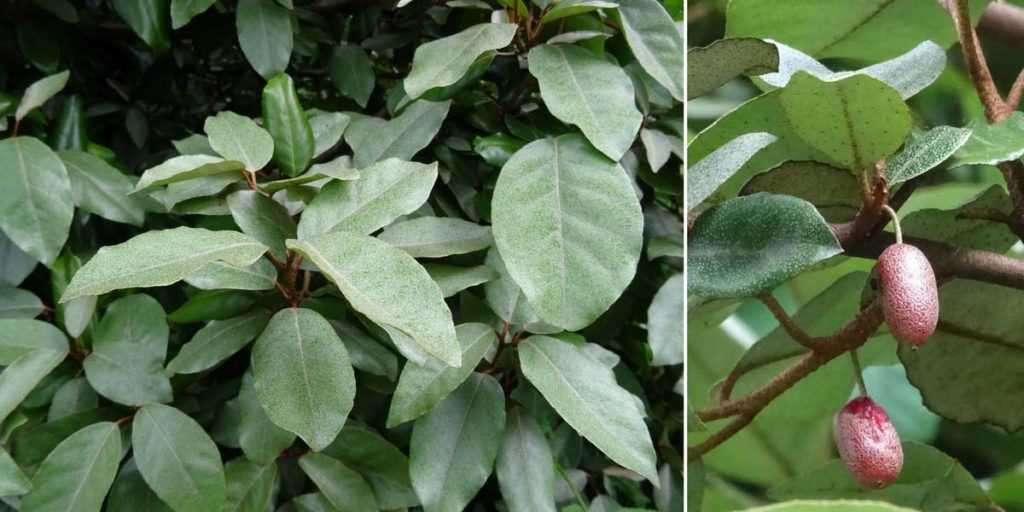
Elaeagnus is exceptionally adaptable, undemanding and very easy to grow. It withstands almost everything: drought, pollution, sea spray and strong winds. It grows throughout France thanks to its hardiness (-15°C to -20°C). It thrives equally in sunny or semi-shaded spots (in hot climates).
It accepts all well-drained soils, even poor and infertile ones. However, it dislikes heavy, chalky soils and waterlogging, especially in winter.
Elaeagnus suits all gardens, coastal or dry. Its moderate size and dense silhouette allow multiple uses: in mixed, trimmed or flowering hedges, as a fruiting hedge or windbreak; it can also be grown as a specimen or in borders. It even takes well to topiary!
Elaeagnus means “sacred olive” in ancient Greek. The vernacular name “chalef” means “willow” in Arabic, likely because some Elaeagnus leaves resemble willow leaves, with which they were once thought to be related.
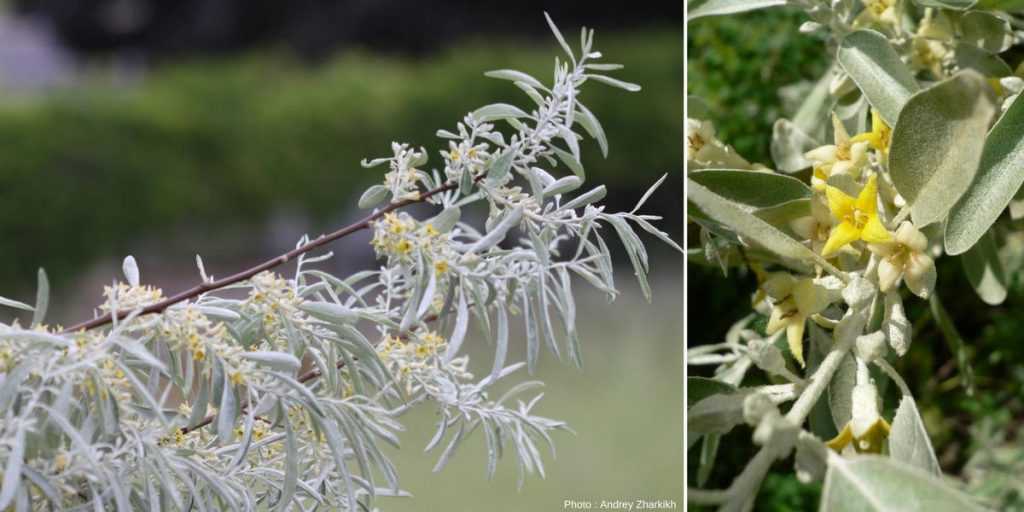
Elaeagnus angustifolia – Russian olive – Flowering branch and flower detail
Species and varieties
There are around fifty species of Elaeagnus worldwide, but only a few are available for sale in France, which can be divided into evergreen Elaeagnus such as Elaeagnus ebbingei, which comes in around ten cultivars including the famous ‘Limelight’, and deciduous varieties like Elaeagnus angustifolia.
Elaeagnus also vary in size, ranging from hedge or border shrubs that don’t exceed 3m in height to small trees (up to 10m tall).
You can choose variegated foliage varieties (‘Gilt Edge’, ‘Limelight’, ‘Maculata’), perfect for brightening up dull areas of the garden, especially as they retain their foliage in winter, or opt for shrubs with silvery foliage (angustifolia or commutata) that play beautifully with wind and light.
All are hardy, highly adaptable, fast-growing, and can be used for hedging—particularly Elaeagnus ebbingei and its hybrids, which are very popular—but also in coastal areas, as standalone specimens, or for topiary…
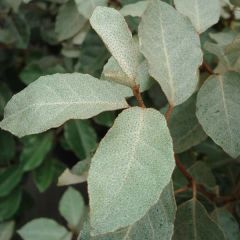
Elaeagnus ebbingei - Oleaster Silverberry
- Flowering time October to December
- Height at maturity 3 m
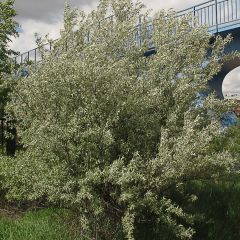
Elaeagnus angustifolia - Russian Olive
- Flowering time June, July
- Height at maturity 5 m

Elaeagnus ebbingei Limelight - Oleaster
- Flowering time October to December
- Height at maturity 3 m

Elaeagnus ebbingei Gilt Edge - Oleaster
- Flowering time October to December
- Height at maturity 2 m

Elaeagnus commutata Zempin - Silverberry
- Flowering time June, July
- Height at maturity 3 m
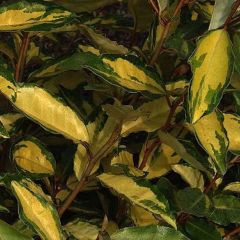
Elaeagnus ebbingei Eleador - Oleaster
- Flowering time October to December
- Height at maturity 1,75 m
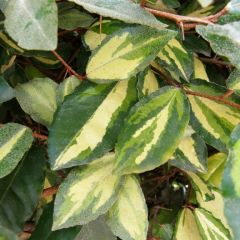
Elaeagnus pungens Variegata
- Height at maturity 3,50 m
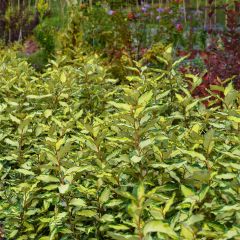
Elaeagnus ebbingei Maryline - Oleaster
- Flowering time October to December
- Height at maturity 2 m
Discover other Elaeagnus - Oleaster
Planting
Where to Plant Elaeagnus
LElaeagnus can be planted almost anywhere in France. Deciduous varieties, with their good cold resistance, can withstand frosts down to -20°C. Some evergreen species like Elaeagnus ebbingei offer less hardiness. Although capable of tolerating short frosts around -12°C in well-drained soil, they are better suited to mild climates. Evergreen Elaeagnus tolerate summer drought perfectly once established, while deciduous types are more cold-resistant but slightly less drought-tolerant.
Its suckering root system helps stabilise soil and withstand strong winds. It handles sea spray well, making it common in coastal gardens. This compact shrub suits small gardens or urban spaces, especially as it resists pollution.
LElaeagnus grows equally well in full sun or partial shade, though in hot climates, shelter from direct sun prevents leaf scorch (especially for variegated varieties). Its drought tolerance allows cultivation in poor, even stony soils, as it enriches surrounding soil via root bacteria.
Adaptable to most soils, it thrives in any well-drained garden soil – only avoiding heavy, waterlogged soils (especially in winter) and limestone. Persistently wet soil will almost certainly kill it! The exception is Elaeagnus commutata Zempin, a hardy cultivar tolerating limestone, sandy, dry or damp soils!
Fast-growing Elaeagnus works perfectly for quick hedges. Evergreen varieties, decorative year-round, excel in informal or formal hedges (single or mixed species). With sharp thorns, they also make excellent defensive hedges.
Yellow-variegated cultivars like ‘Gilt Edge’ or ‘Limelight’ suit standalone planting in beds. Compact varieties allow container growing on patios or balconies to enjoy their remarkable fragrance.
When to Plant Oleaster
Plant Elaeagnus in spring (March) or autumn (September) to encourage rooting before winter. Planting from February to May is possible, avoiding frost or extreme heat.
How to Plant Elaeagnus
1) In the ground
For hedges: Space plants 0.8–1m apart in light, well-drained soil with minimal limestone.
- Dig a hole/trench 3x wider than the rootball and 40–50cm deep
- Mix excavated soil 50:50 with compost
- Add gravel or clay pebbles for perfect drainage
- Position the shrub centrally, crown level with soil
- Backfill around roots
- Straighten and firm soil with your foot
- Water thoroughly at planting and weekly in the first year
2) Container growing
Possible in pots ≥30cm tall and 40cm wide. Choose evergreen varieties with very compact forms like Elaeagnus ebbingei Compacta or Elaeagnus ebbingei ‘Maryline abrela’. Use rich, very free-draining soil (no waterlogging). Add clay pebbles at the base. Water regularly. Repot every 3 years.
→ Learn more in our guide: Growing Elaeagnus in pots
Maintenance and Pruning
Once well established, the Elaeagnus requires little care, as it is a shrub resistant to both cold and intense heat. It will harden over the years.
From March to October, during the period of vigorous growth, water more frequently but sparingly—it cannot tolerate waterlogged soil. Once fully established, it will no longer need watering, even in hot climates. In the first few years, apply a mulch of dead leaves or ferns to protect the base from severe frost.
For all variegated Elaeagnus, any stems reverting to green should be removed. Cut away green shoots and suckers (a phenomenon sometimes observed in variegated varieties), or they will eventually dominate.
Regular pruning is recommended. Elaeagnus grows very quickly, and while it has the advantage of forming hedges rapidly, it should be pruned often—at least twice a year— to maintain a bushy shape, an attractive appearance, and most importantly, the desired height. It can be easily shaped into a trimmed hedge or topiary. If left unpruned, Elaeagnus ebbingei becomes sprawling and may climb if it finds support.
Elaeagnus is not afraid of pruning and can even be cut back hard if necessary, though this will sacrifice its fragrant flowering. Prune in late winter to avoid compromising the blooms.
- In the first few years, carry out formative pruning: cut back by one-third of the height to encourage new stems and dense growth.
- To create a dense boundary hedge, prune preferably twice a year: once in late winter and again in mid-summer.
- For a free-growing hedge or standalone planting, a balancing prune will suffice to maintain a harmonious shape and keep a compact form, abundant flowering and fruiting, and dense foliage. In February-March, while the plant is still dormant—and to enjoy its flowers and fruit—remove damaged or dead branches and trim unruly, wayward, or tangled stems.
Diseases and potential pests
When grown in suitable conditions, the oleaster is a tough shrub resistant to pests. It has few natural enemies. In waterlogged and poorly drained soil, it may be threatened by diseases caused by devastating fungi such as coral spot disease, recognisable by its small orange pustules (how to prevent it?), which lead to dieback or even complete defoliation of the shrub.
In overly chalky or damp soil, it may suffer from chlorosis, which manifests as gradual yellowing of the leaves and, eventually, the decline of the shrub.
A well-drained soil, regularly enriched with compost or peat, will help prevent these issues. Some branches may suddenly dry out completely, indicating water deficiency. Remove the dead branches and water moderately.
Psyllids, a type of sap-sucking aphid, may occasionally infest the shrub and weaken it: yellowing leaves, sticky and deformed young shoots, and the presence of waxy filaments are signs of their presence. Apply a 5% diluted black soap spray, as you would for aphids. They can also be eradicated by natural predators such as ladybirds or hoverflies.
→ Learn more about diseases and pests affecting Eleagnus in our advice sheet.
Propagation
Elaeagnus can be propagated by seed, by suckers or cuttings. The simplest method is to take semi-hardwood cuttings in summer. Growing from seed is rather tedious and time-consuming, as fruiting only occurs 4 to 5 years after sowing.
Semi-hardwood cuttings
- Carry out between mid-July and September
- Using secateurs, cut 10cm shoots from this year’s growth just below a node, selecting stems that are semi-ripe (partially hardened and woody at the base)
- Remove the lower leaves from the stem
- Plant the cuttings in a tray, spaced 10cm apart, in a mix of peat, river sand and compost
- Place under a cold frame, cloche or plastic film
- Keep the growing medium moist until roots develop
- Once well rooted, carefully separate the cuttings and pot them individually in containers filled with compost
- Protect from frost over winter
- Prune back shoots by one third of their height to encourage branching
- Repot as needed and only transplant into open ground two years later in spring
By dividing suckers
You can easily propagate Elaeagnus by dividing suckers. In October, use a spade to separate rooted suckers and replant them immediately, taking care to water well.
Pairing
With its luminous foliage that plays wonderfully with wind and light, the Elaeagnus or Oleaster brightens up dull areas of the garden. Its exceptional adaptability makes it an excellent choice for hedges or borders. Its bushy habit and the brilliance of its variegated leaves make it highly decorative.
It is invaluable in coastal gardens or dry gardens. Highly resistant to pollution, it is also perfect for urban gardens. It blends well in hedges with all types of shrubs, such as cotoneasters or Cistus laurifolius, and as a backdrop in borders for taller varieties, paired with variegated evergreen plants like dogwoods or aucubas.
In a mixed hedge, it will stand out alongside other beautiful shrubs such as Abelia x grandiflora, Arbutus unedo, Amelanchiers, or Buddleia alternifolia Argentea. To complement the luminous tones of its foliage, pair it in a border with other colourful plants like lavenders, creeping ceanothus, or shrubby mallows.
The variegated cultivars of E. x ebbingei, with evergreen leaves edged or splashed with bright yellow or contrasting green, work well with blue-flowered ceanothus or can serve as a support for climbers like Lonicera nitida ‘Lemon Beauty’.
In a free-flowering hedge, they will shine alongside a Buddleia davidii ‘Masquerade’, or in a defensive hedge with a Pyracantha ‘Soleil d’or’.
For a striking effect, mix different Elaeagnus species together in a hedge, combining evergreen and deciduous varieties at will, and pairing them with shrubs that flower at different times, such as Kerria japonica or Japanese cornel, Viburnum tinus, weigelas, smoke bushes, deutzias, mock oranges, or forsythias.
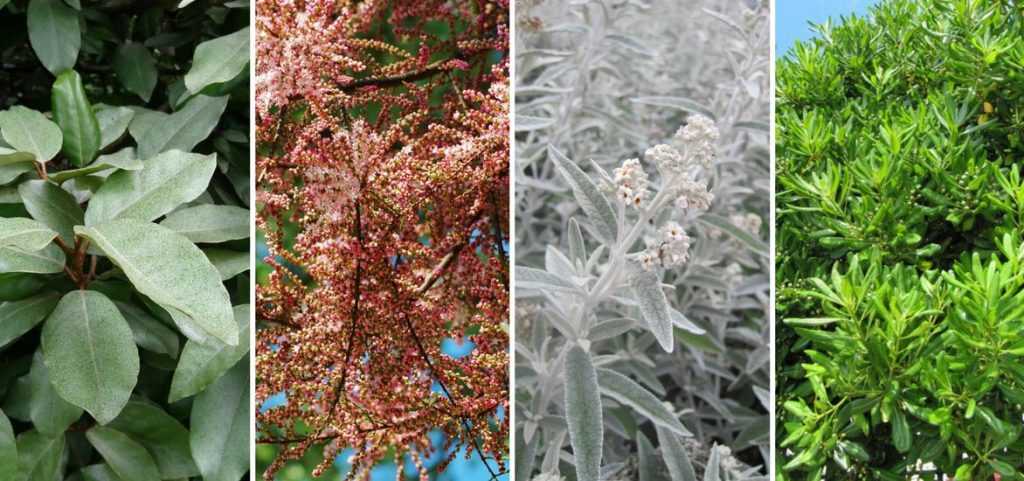
An example of a coastal hedge combination: Eleagnus ebbingei, Tamarix, Buddleia ‘Silver Anniversary’ and Pittosporum tobira
While all Elaeagnus varieties pair beautifully with each other, they also combine perfectly with Escallonia, Olearia, tamarisks, and Griselinia, as well as Euonymus alatus (Winged Spindle) and Amelanchier spicata. In a windbreak hedge, pair it with photinia.
While deciduous Elaeagnus varieties are stunning in spring, after flowering, they revert to a rather plain appearance—so be sure to surround them well. Buddleia ‘Silver Anniversary’ will be the ideal companion to take over from Elaeagnus commutata Zempin in a silvery-grey harmony, enhanced by old roses, blue-flowered shrubs, or even yellow-flowered cinquefoils.
Useful resources
- Discover our Elaeagnus or oleaster at all prices including some rare new varieties!
- Learn more about pruning Elaeagnus
- How to choose the right Elaeagnus
- Discover our ideas for pairing Elaeagnus
- Our advice sheet: Variegated Elaeagnus: the most beautiful varieties
- Discover our advice sheet: plants resistant to sea spray
- Discover Olivier’s video about Elaeagnus umbellata
Frequently asked questions
-
Why is my eleagnus turning yellow?
The oleaster is known as a hardy plant, even in challenging conditions. There are many possible causes for issues. However, if the leaves turn yellow and gradually fall, it is likely suffering from iron chlorosis caused by excess lime, moisture, or a mineral deficiency in the soil. Treat with chelated iron and add compost by lightly scratching it into the soil around the base of the shrub.
It may also fall victim to an infestation of psyllids, harmful insects that cause yellowing and withering of the leaves. Introducing beneficial insects like ladybirds and spraying with soapy water should help eliminate them.
-
Are the leaves of my eleagnus drying out, is this serious?
During periods of intense heat and prolonged drought, particularly in young specimens, some branches may suddenly dry out completely, which likely indicates a lack of water. Remove the dead branches and water regularly but avoid overwatering, as this shrub is sensitive to stagnant moisture around its base. It should recover!
*(Note: The translation maintains the original meaning while adapting to British English conventions, including spelling ("arouse" → "water") and natural phrasing. Technical terms like "branches" and "humidité stagnante" are accurately rendered as "branches" and "stagnant moisture." The tone remains practical and reassuring for gardeners.)*
**Ready for WordPress integration** – No code/formatting altered.
-
Why are green shoots appearing on my variegated eleagnus?
This is a fairly characteristic phenomenon in variegated foliage plants where young shoots turn green. This is known as "reversion to type." The variegated stems that turn green should be removed as soon as they appear, otherwise your variegated shrub may become entirely green! This reversion phenomenon occurs when the plant is over-fertilised with nitrogen or placed in a location that is either too sunny or, conversely, too shady.
- Subscribe!
- Contents




































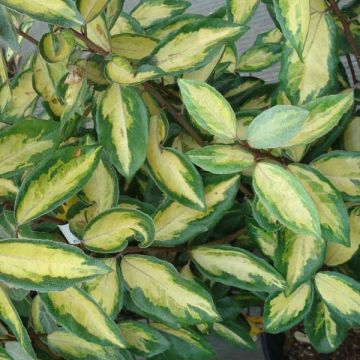
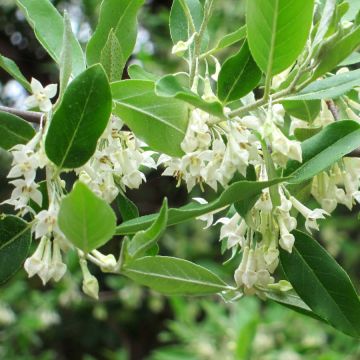
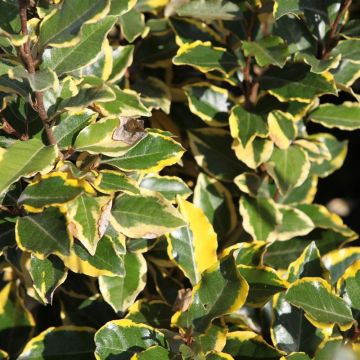
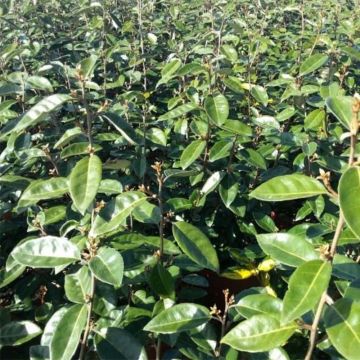

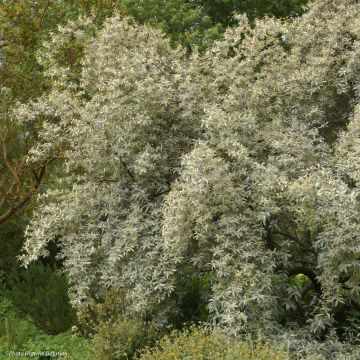
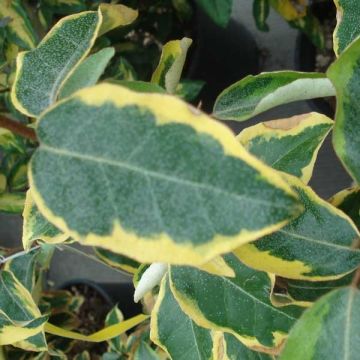
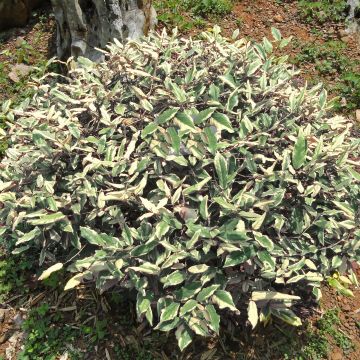

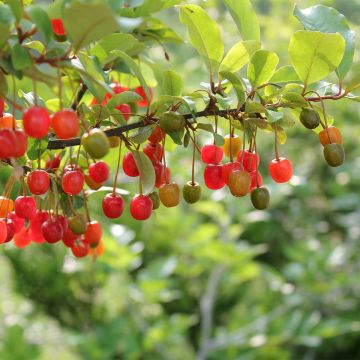

Comments